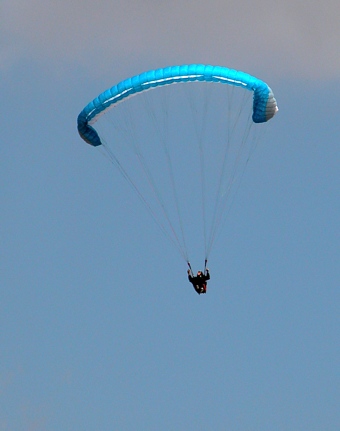The problems with big ears:
Deep Stall
Most of the accidents in big ears are the result of the glider entering a deep stall at low level, resulting in the pilot impacting the ground. The pilot usually hits the ground going vertically down at around six meters per second. If the pilot is well protected with a back protector, he might survive the impact with little injury. Some regard this as a success story for the design of back protectors, but I think that it’s better to prevent the accident from happening in the first place, and I continue to argue that these accidents can be easily avoided.
The problem with big ears is quite simply that the glider is not flying as it is designed to fly. The angle of attack is higher, the wing loading is higher and the airflow at the tip is completely messed up. All this results in the glider not flying as well as it should do, and it's sometimes possible for the wing to enter a deep stall accidentally. If there is any slight problem with the wing then this is the time that it will surface.
These problems may be caused by the glider being old and porous, by line shrinkage, stretch in the sail, or by the pilot flying outside of the weight range. Being either too heavy or too light can cause deep stall problems.
The problem is, therefore, that you can accidentally enter deep stall from big ears, and in some extreme cases, the wing will not recover automatically. The solution is simple. Do not do big ears less than 100 metres above the ground. 100 metres should give the pilot time to realize that he's in a deep stall, and to recover from it.
Doing big ears is a poor substitute for active piloting. People often do big ears in rough air to reduce the pitching of the glider. This in itself is not a bad thing, but the problem is that when you're in big ears you cannot fly the glider actively at all. The brakes become useless for controlling the pitching of the wing, and you have no directional control with the brakes.
Also, you do not have the ability to stop the wing from collapsing when you feel this might happen. Pulling big ears reduces pitching, but not as much as proper active flying. This means that pilots use it as a poor substitute for active piloting. Personally, I feel out of control in big ears, which makes me nervous.
Out of control
The last problem with big ears, especially on landing approach, is that pilots use it close to the ground when they need to be concentrating on their landing approach. As they reach up to pull in big ears, they lose control through the brakes, and at the same time they focus their concentration on pulling in the correct line or risers to do the big ears. This means they often look up when they need to be looking forwards and judging their approach. This, more often than not, ends up in a bad landing. Some pilots even do big ears to show off their new-found skills to those in the landing field.
When to use big ears
Big ears should only be used as an occasional emergency descent procedure. Rather like B-lining, which is an altogether safer procedure for losing height, it should be treated with a lot of respect and should not be done at low level unless it is absolutely unavoidable. All pilots should feel unsafe when they do big ears.
Unfortunately, many pilots feel the opposite and use it when conditions are bad. They use big ears as if it gives them more security - a false sense of security that actually compromises their safety. Above all, pilots should not use big ears below 100 metres above ground level.
|


Steve Ham summed it up nicely when he said: "You should only fold up your wing when you put it in the bag, and not before."
|

